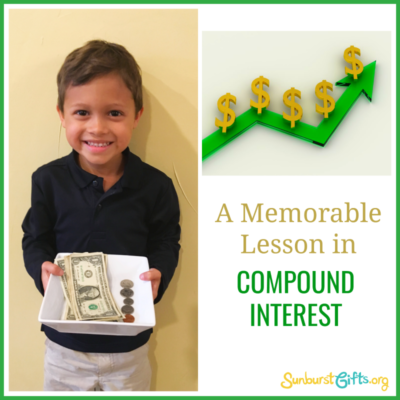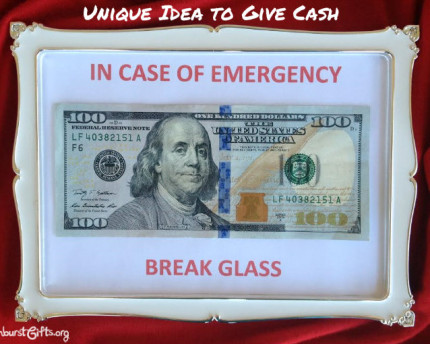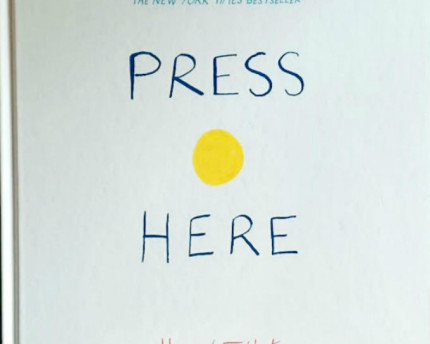Memorable Lesson in the Power of Compound Interest
This gift is less about the money, but leaving children with a money lesson that will stick with them the rest of their life.
 When someone begins to understand the full power of compound interest and how it causes his or her savings to grow quickly over time, it motivates that individual to save money early and regularly.
When someone begins to understand the full power of compound interest and how it causes his or her savings to grow quickly over time, it motivates that individual to save money early and regularly.
I tell my kids, “The bank pays you money for letting it hold your money. The longer the bank holds your money for you, the more free money you get!”
Kids may not grasp the concept of saving for retirement, but even my five-year old gets excited about saving his money towards a future car for when he’s old enough to drive.
I’ve been wanting to teach my son about compound interest, but it still seemed too complicated until I came across an article from my favorite website TheSimpleDollar.com.
I’ve taken it’s lesson on the power of compound interest and created a simple step-by-step guide for parents and caregivers.
Tell a child that you’re going show them the power of compound interest for 8 weeks or 56 days, and at the end of it they can put the money in their savings account or use it for the two of you to do something fun.
To build excitement, use a calendar to keep track of the days and cross off the days one by one.
Money Experiment on the Power of Compound Interest
Day 1: Put 10 pennies in a container.
Tell them the money is going to earn 10% in interest, which means that for every 10 pennies in the container, you’ll add another penny.
Ask them, “How much total money do you think there will be at the end?” Encourage them to guess and write it down on a piece of paper. Have adults guess too!
Days 2-10: Together, count how many pennies are in the container. Add 1 penny to the container each day.
Days 11-15: Together, count how many pennies are in the container. Add 2 pennies to the container each day.
Days 16-19: Together, count how many pennies are in the container. Add 3 pennies to the container each day.
Days 20: Together, count how many pennies are in the container. Add 4 pennies to the container. I suggest you take out every 10 pennies and replace them with dimes. You should have 4 dimes and 4 pennies.
Day 21-22: Together, count how much money is in the container. Add 4 pennies to the container.
Day 23-24: Together, count how much money is in the container. Add 5 pennies to the container.
You should have 6 dimes on Day 24.
Day 25-26: Together, count how much money is in the container. Add 6 pennies to the container.
Day 27-28: Together, count how much money is in the container. Add 7 pennies to the container.
Day 29: Together, count how much money is in the container. Add 8 pennies to the container.
Day 30: Together, count how much money is in the container. Add 9 pennies to the container.
You should have $1 and 3 pennies on Day 30.
Day 31: Together, count how much money is in the container. Add 1 dime to the container.
Day 32: Together, count how much money is in the container. Add 1 dime and 1 penny to the container.
Day 33: Together, count how much money is in the container. Add 1 dime and 2 pennies to the container.
Day 34: Together, count how much money is in the container. Add 1 dime and 3 pennies to the container.
Day 35: Together, count how much money is in the container. Add 1 dime and 4 pennies to the container.
Day 36: Together, count how much money is in the container. Add 1 dime and 6 pennies to the container.
Day 37: Together, count how much money is in the container. Add 1 dime and 7 pennies to the container.
Day 38: Together, count how much money is in the container. Add 1 dime and 9 pennies to the container.
Day 39: Together, count how much money is in the container. Add 2 dimes and 1 penny to the container.
Day 40: Together, count how much money is in the container. Add 2 dimes and 3 pennies to the container.
You should have a total of $2.59 on Day 40.
Day 41: Together, count how much money is in the container. Add 2 dimes and 5 pennies to the container.
Day 42: Together, count how much money is in the container. Add 2 dimes and 8 pennies to the container.
Day 43: Together, count how much money is in the container. Add 3 dimes and 1 penny to the container.
Day 44: Together, count how much money is in the container. Add 3 dimes and 4 pennies to the container.
Day 45: Together, count how much money is in the container. Add 3 dimes and 7 pennies to the container.
Day 46: Together, count how much money is in the container. Add 4 dimes and 1 penny to the container.
Day 47: Together, count how much money is in the container. Add 4 dimes and 5 pennies to the container.
Day 48: Together, count how much money is in the container. Add 4 dimes and 9 pennies to the container.
Day 49: Together, count how much money is in the container. Add 5 dimes and 4 pennies to the container.
Day 50: Together, count how much money is in the container. Add 6 dimes to the container.
Day 51: Together, count how much money is in the container. Add 6 dimes and 6 pennies to the container.
Day 52: Together, count how much money is in the container. Add 7 dimes and 2 pennies to the container.
Day 53: Together, count how much money is in the container. Add 7 dimes and 9 pennies to the container.
Day 54: Together, count how much money is in the container. Add 8 dimes and 7 pennies to the container.
Day 55: Together, count how much money is in the container. Add 9 dimes and 6 pennies to the container.
Day 56: Together, count how much money is in the container. Add $1 and 6 pennies to the container.
A whole dollar of interest! That should make an impression.
You should have a total of $11.66 on Day 56.
I know my guess about what the final total would be wasn’t close to being that high. It’s amazing how 10 cents can grow that quickly in only two months!
By the way, you can keep going several more days if you wish until you get to $2 of interest. That will wow them even again!
My son really loved doing this activity, and he looked forward to receiving his interest from “the bank” every single day.
As a bonus, it helped him practice and improve his math. He was able to use math in a real-life scenario instead of only in the classroom. There are so many life lessons wrapped up in this important financial lesson.
Teaching kids about money is never just about money. – Dave Ramsey




Leave a Reply